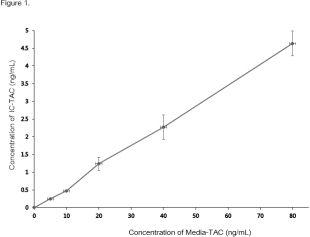Effect of Inflammation on Concentration of Intracellular Tacrolimus.
1Internal Medicine, Seoul National University College of Medicine, Seoul, Republic of Korea
2Kidney Research Institute, Seoul National University, Seoul, Republic of Korea.
Meeting: 2016 American Transplant Congress
Abstract number: D275
Keywords: FK506, Inflammation, Kidney transplantation, Rejection
Session Information
Session Name: Poster Session D: Poster Session II: Kidney Complications-Other
Session Type: Poster Session
Date: Tuesday, June 14, 2016
Session Time: 6:00pm-7:00pm
 Presentation Time: 6:00pm-7:00pm
Presentation Time: 6:00pm-7:00pm
Location: Halls C&D
Background: The use of calcineurin inhibitors improved the outcome for transplant recipients. However, acute rejection (AR) and infection remained still an unsolved problem. We evaluated the effect of inflammation on intracellular concentrations of tacrolimus.
Methods: Jurkat T cell treated with a concentration range of tacrolimus for 21hrours and stimulated with PMA/ionomycin for 3horus. Intracellular concentration of tacrolimus were measured using LC-MS/MS in the absence and presence of tacrolimus, PMA/ionomycin. The effect of tacrolimus on cell proliferation were measured by MTS assay and interlieukin-2, 8 and interferon gamma production were measured using qPCR. We also measured both whole blood and intracellular concentrations of tacrolimus (WB-TAC and IC-TAC) in 9 kidney recipients with AR and stable status. The tacrolimus ratio was defined as the ratio between IC-TAC and WB-TAC (IC-TAC/WB-TAC).
Results: The levels of IC-TAC increase proportionally with the levels of media-TAC in Jurkat T cells  . After stimulation with PMA/ionomycin, the proportion of T cells producing IFN-γ, IL-2 and 8 was higher in the low IC-TAC group than the high IC-TAC group. In addition, the levels of IC-TAC were decreased after stimulation. However, in human data, only one person's TAC-ratio was lower at the time of AR than stable status. The other patients' TAC-ratio were higher at inflammatory status (infection: n=3, rejection: n=5) than stable status. The person who had lower level of TAC-ratio at the time of AR experienced recurrent inflammatory conditions during 1month; one is pneumonia and the other one is acute rejection. Other patients did not experience an inflammatory conditions at least 6 months before this event.
. After stimulation with PMA/ionomycin, the proportion of T cells producing IFN-γ, IL-2 and 8 was higher in the low IC-TAC group than the high IC-TAC group. In addition, the levels of IC-TAC were decreased after stimulation. However, in human data, only one person's TAC-ratio was lower at the time of AR than stable status. The other patients' TAC-ratio were higher at inflammatory status (infection: n=3, rejection: n=5) than stable status. The person who had lower level of TAC-ratio at the time of AR experienced recurrent inflammatory conditions during 1month; one is pneumonia and the other one is acute rejection. Other patients did not experience an inflammatory conditions at least 6 months before this event.
Conclusions: This study suggest a hypothesis that chronic or recurrent inflammation such as rejection, infection, could decreased the intracellular tacrolimus level. Further studies are warranted to explain the difference between human data and in-vivo study.
CITATION INFORMATION: Bae E, Yang S, Han S, Park J.-Y, Lee H, Kim Y. Effect of Inflammation on Concentration of Intracellular Tacrolimus. Am J Transplant. 2016;16 (suppl 3).
To cite this abstract in AMA style:
Bae E, Yang S, Han S, Park J-Y, Lee H, Kim Y. Effect of Inflammation on Concentration of Intracellular Tacrolimus. [abstract]. Am J Transplant. 2016; 16 (suppl 3). https://atcmeetingabstracts.com/abstract/effect-of-inflammation-on-concentration-of-intracellular-tacrolimus/. Accessed July 18, 2025.« Back to 2016 American Transplant Congress
